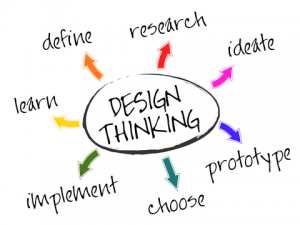 This month’s “3 Questions With” post is a conversation with Garett Dworman, TecEd senior UX consultant with expertise in user research, information architecture, and user-centered design. Garett has a strong interest in how people disseminate, access, and consume information.
This month’s “3 Questions With” post is a conversation with Garett Dworman, TecEd senior UX consultant with expertise in user research, information architecture, and user-centered design. Garett has a strong interest in how people disseminate, access, and consume information.
1. How do you characterize UX design?
Design is a problem-solving process that must combine analysis of a problem with creativity for inventing a solution (see Pabini Gabriel-Petit’s article Design Is a Process, Not a Methodology for a good discussion of design and its definition). Two thought processes are important to design – analysis and creation.
Analytic design thinking fits something into the constraints of the environment. I think of analytic design thinking as similar to playing with a jigsaw puzzle that is missing a few pieces. You have to find out what is missing from the environment and create a piece that fills the gap; it’s about finding a solution to a problem. Analytic thinking is most evident in discovery activities such as content modeling, workflow analysis, and affinity diagramming.
Creative design thinking synthesizes something new. I think of creative design as similar to playing with Lego bricks. You have to take building blocks and put them together in ways that haven’t been considered before or apply them to environments to which they’ve not yet been applied – it’s about finding an exciting, innovative experience. Creative thinking is most evident in generative activities such as sketching, wireframing, and visual design.
2. Are both analytic and creative thinking important in a design project?
Absolutely. In any design project it is impossible to completely separate the two.
The most analytic of design projects are acts of creation in which the designer must produce something that didn’t exist before. Even if each individual piece of a design has been around for years, it takes creativity to find the right combination of those pieces that will solve the problem.
The most creative of design projects produce nothing more than decoration unless they meet a need or solve a problem. Much of the technology world gawks at the creative genius that produced the iPod. However, that accomplishment began with analysis that recognized the need for easy-to-use music players and the availability of new technology that could make it happen and it’s worth reviewing that scenario today (see Straight Dope on the iPod’s Birth).
Some projects may require more analytic design thinking; some projects may require more creative design thinking, so the mix will vary. A nice description of how design projects can vary the mix is Jared Spool’s article, 5 Design Decision Styles. What’s Yours? This article describes five styles by which design projects vary the amount of research, and therefore the amount of analytic thinking, is performed on which to base creative decisions.
3. Why do you think it is important to identify analytic and creative thinking in the design process?
Because too often people think of design as synonymous with creative thinking. Creative design thinking is sexier. It is within the world of creative design thinking that ideation arises, that innovation emerges, that grand invention fashions the hot, new, beautiful – wow factor.
Often we hear questions like how do designers create the cool new thing? How can an organization inspire designers to find that next killer app? Certainly, these are important questions, but not more important than asking – how do designers find the solution to a given business problem; how can an organization inspire designers to enable efficient workflows? The latter can be the more important questions to ask.
Gerry McGovern (Why are ugly websites so successful?) states that simple, unimpressive, even ugly GUIs are often more effective and usable than beautiful, sexy ones. Getting the content and the functionality right is more important than making it look good. The bottom line question for design is, does the solution meet the needs of the users and solve their problem?
Analytic thinking is necessary to know what the important problems are. It sets the foundation for and targets creative thinking to the right problem. Analytic and creative thinking together are the yin and yang of design thinking.
“[Design thinking is] a methodology that imbues the full spectrum of innovation activities with a human-centered design ethos. By this I mean that innovation is powered by a thorough understanding, through direct observation, of what people want and need in their lives and what they like or dislike about the way particular products are made, packaged, marketed, sold, and supported”. (Tim Brown, Design Thinking, Harvard Business Review).

